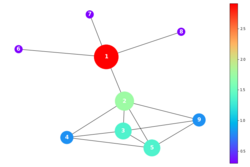Distinctiveness centrality

Distinctiveness centrality is a network centrality measure, used in graph analysis. It is similar to degree centrality, but weighted in order to attribute higher importance to distinctive, non-redundant, connections.[1]
In general, many traditional centrality metrics attribute less importance to nodes’ connections with the network periphery.[2] Distinctiveness centrality, on the other hand, attributes more importance to nodes that have links to loosely-connected peers.[3] Distinctiveness penalizes redundant connections.
Calculation
There are five different metrics that can be used to calculate distinctiveness centrality – namely D1, D2, D3, D4 and D5. They only differ with regard to the weighting factor used. In addition, only D1, D3 and D4 are designed to consider arc weights.
Formulas are presented for a (weighted) undirected graph G, made of n nodes and m arcs. If two nodes, i and j, are not connected, then [math]\displaystyle{ w_{ij}=0 }[/math], otherwise [math]\displaystyle{ w_{ij} \ge 1 }[/math]. If the graph is unweighted, each arc weight is considered equal to 1. In the following, [math]\displaystyle{ g_j }[/math] is the degree of node j and [math]\displaystyle{ I_{(f)} }[/math] is the indicator function which equals 1 if [math]\displaystyle{ f=\text{TRUE} }[/math], i.e. if there is an arc connecting nodes i and j. An exponent [math]\displaystyle{ \alpha \ge 1 }[/math] is used in the formulas to allow a stronger penalization of connections with highly connected nodes.
D1 of node i is calculated as:
- [math]\displaystyle{ D_1 (i) = \sum_{j=1, j\neq i}^n w_{ij} \log_{10}\frac{n-1}{{g_j}^\alpha}. }[/math]
D2 of node i is calculated as:
- [math]\displaystyle{ D_2 (i) = \sum_{j=1,j\neq i}^n \log_{10}\frac{n-1}{{g_j}^\alpha}I_{(w_{ij}\gt 0)}. }[/math]
D3 of node i is calculated as:
- [math]\displaystyle{ D_3 (i) = \sum_{j=1,j\neq i}^n w_{ij}\log_{10} \frac{\sum_{k,\ell=1,k\neq\ell}^n \frac{w_{k\ell}}{2}}{ \sum_{k=1,k\neq j}^n {{w_{jk}}^\alpha}-{w_{ij}}^\alpha+1}. }[/math]
D4 of node i is calculated as:
- [math]\displaystyle{ D_4(i) = \sum_{j=1,j\neq i}^n w_{ij} \frac{{w_{ij}}^\alpha}{\sum_{k=1,k\neq j}^n {w_{jk}}^\alpha}. }[/math]
D5 of node i is calculated as:
- [math]\displaystyle{ D_5 (i) = \sum_{j=1,j\neq i}^n \frac{1}{{g_j}^\alpha} I_{(w_{ij}\gt 0)}. }[/math]
Directed networks
It is possible to extend distinctiveness centrality to directed networks,[3] in order to value incoming arcs more, if they originate at nodes with low out-degree. Indeed, a connection from a node sending arcs towards all other nodes is considered of little value. Let’s take the case of Sarah receiving a love-letter from Jessica, who is sending love-letters to all people in the neighborhood. The letter is much less important to Sarah than the case of Jessica only sending one letter (to Sarah). Similarly, outgoing arcs are valued more if they reach peers with low in-degree. This means that if Sarah receives a love letter from Jessica only, she will pay much more attention to it than the case of receiving many love letters, from all the people in the neighborhood.
See also
References
- ↑ Fronzetti Colladon, Andrea (2020-05-22). "Distinctiveness Centrality in Social Networks: a Python Tutorial" (in en). https://towardsdatascience.com/distinctiveness-centrality-56c1e6762328.
- ↑ Wasserman, Stanley; Faust, Katherine (1994-11-25). Social Network Analysis. Cambridge University Press. doi:10.1017/cbo9780511815478. ISBN 978-0-521-38707-1.
- ↑ 3.0 3.1 Fronzetti Colladon, Andrea; Naldi, Maurizio (2020-05-22). Xiao, Gaoxi. ed. "Distinctiveness centrality in social networks" (in en). PLOS ONE 15 (5): e0233276. doi:10.1371/journal.pone.0233276. ISSN 1932-6203. PMID 32442196. Bibcode: 2020PLoSO..1533276F.
External links
- Python package to calculate the distinctiveness centrality.

